![]()
![]()
![]()
Use LEFT and RIGHT arrow keys to navigate between flashcards;
Use UP and DOWN arrow keys to flip the card;
H to show hint;
A reads text to speech;
53 Cards in this Set
- Front
- Back
|
Direct proportion |
Two or more quantities increase or decrease on the same ratio |
|
|
Common rafter |
Extends perpendicular from ridge to cap plate |
|
|
Rafter run |
Centre of ridge to outside of outside wall |
|
|
Rafter span |
Face of support to face of support |
|
|
Rafter line length |
Sloped length from the centre of the ridge to the outside edge of the wall |
|
|
Rafter tail line length |
Length of the overhang or projection |
|
|
Total rafter line length |
Total length of the rafter run and the overhang run |
|
|
Shortenings |
Measured from the working point at the center of the ridge to the outside of the fascia |
|
|
Perpendicular shortenings |
Must be measured at 90 degrees to the working plumb line |
|
|
Diagonal shortenings |
Shootings are always done at a diagonal to other framing members |
|
|
Full diagonal shortenings |
All Hip or valley rafter outside the exterior walls will be full diagonal thickness |
|
|
Half diagonal |
All hip or valley shortening within the boundaries of the exterior wall |
|
|
Dropped/ backed rafter |
Hip rafter drops so it can sit lower in relation to the common rafter. |
|
|
Gable stud |
Placed directly under the stud, Framed triangular shaped walls at a table roof |
|
|
Notched gable stud |
Notches cut into the top of gable look outs |
|
|
Dropped gable |
Lowered so gable lookouts can run over it |
|
|
Lookouts |
Support the rake rafter. Project in as far as they project out. Spaced to provide the edge support for the roof sheathing |
|
|
Ladder systems |
Lookouts placed on edge rested on top of a dropped gable rafter, short gable end wall frames underneath them. |
|
|
Barge/ fly / verge rafter |
Also known as rake rafter |
|
|
Ridge board/ridge beam |
Maintains rafter spacing, provides roof sheathing at ridge |
|
|
Collar tie |
Horizontal members nailed to the sides of opposing pairs of rafters. Placed upper third of total rise of roof |
|
|
Seat cut extension |
Extends out to end of the rafter |
|
|
Theoretical measuring line |
Runs parallel to the end of the rafter. Intersect the corner of birds mouth and up to the working point at the ridge. |
|
|
Common difference |
1- hip Jack's become shorter by a consistent amount. 2- centre table stud working outside wall becomes shorter |
|
|
Hip rafter |
Runs diagonally 45 degrees from outside corner of the building to the ridge. Hip roof requires four hip rafters |
|
|
Pin rafter / end common |
Runs 90 degrees connecting the plate and the ridge |
|
|
45 degree rule |
Only used for hip and valley rafters |
|
|
Gable end overhang framing |
Overhang is required at either end, special framing must be used to allow the roof to project past walls. Lookout rafters are used |
|
|
Short walls built around perimeter |
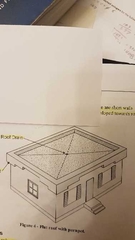
|
|
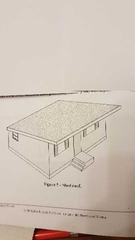
|
Lean-to roofs or flat roof |
|
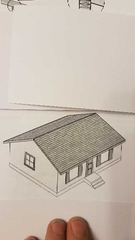
|
Gable roof |
|
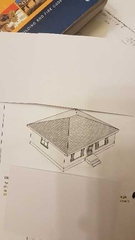
|
Hip roof. 45 degree angle to the wall and ridge |
|
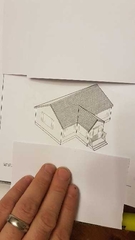
|
Intersecting roof, 90 degree angle. Valley is created |
|

|
Gambrel roof. Also called barn roof Four sloping surfaces, two sets rafters |
|
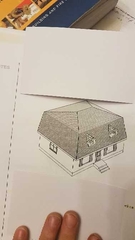
|
Mansard roof, 8 sloping surfaces. 8 hip rafters |
|
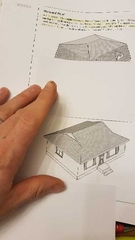
|
Dutch hip roof. Combination of hip and gable roof |
|
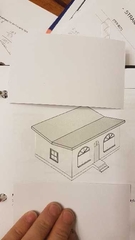
|
Butterfly roof Inverted gable roof |
|

|
Monitor roof Combination of gable and shed roof. Commerical or agricultural building |
|

|
Dormers Shed and gable dormers |
|
|
Intersecting roof |
Two or more roofs joined together |
|
|
Supporting valley |
Extends from the major roof ridge to the corner of the building intersection Same line length as the hip |
|
|
Supported valley |
Extends from the supporting valley rafter to the corner of the building intersection. Parallel to the minor hip rafter. Same horizontal run as the minor hip, same line length |
|
|
Valley jack |
Runs 90 degrees to the ridge, extends from either major or minor ridge down to the valley. Identical to the common rafter. |
|
|
Valley jack on minor roof |
Equal to its distance form the intersection of the supporting and supported valley rafter |
|
|
Longest Valley jack on major roof |
Find its distance from the corner at which the walls intersect. |
|
|
Valley cripple jack |
Runs from valley to valley. Extend from the supporting valley to the supported valley. Shortenings half the diagonal thickness of the valley rafter. Opposite cheek cuts |
|
|
Hip-valley cripple jack |
Runs from hip to supporting valley. Does not touch ridge or wall plate. Can be seen as the middle section of a common rafter. Equal to the offset of the minor roof |
|
|
Intersecting roof lines major Gable |
Minor gable |
|
|
Major intersecting roof lines Gable |
Minor hip |
|
|
Major intersecting roof lines Hip |
Minor intersecting roof lines Gable |
|
|
Major intersecting roof lines Hip |
Minor intersecting roof lines Hip |
|
|
What's the layout of the upper end of valley jack rafter |
Half the thickness of the ridge |
|
|
Layout of the lower end of the valley jack rafter |
Meets valley at 45 degree and a single cheek cut |

